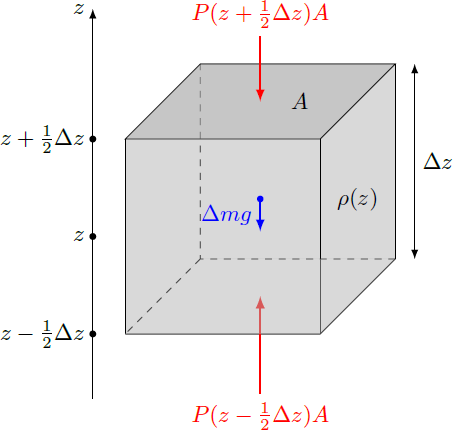Atmospheric physics 3: Hydrostatic equation
In fact, the atmosphere consists of compressible gases, so that the mass density of the air decreases continuously with the altitude . However, the weight of the gas layers must be supported by the pressure gradient in the atmosphere. The balance of compressive forces and gravitation is expressed by the hydrostatic equation: with the gravitational acceleration .

This equation can be derived as follows: We consider a cuboid volume element of the atmosphere with the base area parallel to the Earth's surface and the height (see the diagramm on the right). The mass of this volume is , so that a weight acts on the entire volume. In addition, the pressures and act respectively on the top and bottom of the cuboid. In the static case, the sum of all forces on the volume element must be zero. In the limit , the pressure difference changes into the derivative , so that the difference equation becomes a differential equation. Since the expression in parentheses must be zero it follows
Easy Math Editor
This discussion board is a place to discuss our Daily Challenges and the math and science related to those challenges. Explanations are more than just a solution — they should explain the steps and thinking strategies that you used to obtain the solution. Comments should further the discussion of math and science.
When posting on Brilliant:
*italics*or_italics_**bold**or__bold__paragraph 1
paragraph 2
[example link](https://brilliant.org)> This is a quote# I indented these lines # 4 spaces, and now they show # up as a code block. print "hello world"\(...\)or\[...\]to ensure proper formatting.2 \times 32^{34}a_{i-1}\frac{2}{3}\sqrt{2}\sum_{i=1}^3\sin \theta\boxed{123}Comments
There are no comments in this discussion.